Headspace NewAccess System Analysis: Requirements and SDLC Report
VerifiedAdded on 2023/03/17
|6
|2340
|74
Report
AI Summary
This report provides a system analysis of the NewAccess system, focusing on non-functional requirements, cloud-based solutions, and Software Development Life Cycle (SDLC) approaches. It details the performance, availability, compliance, usability, security, scalability, adaptability, maintainability, interoperability, and integration aspects of the system. The report then evaluates the strengths and weaknesses of cloud-based solutions, particularly concerning security, privacy, cost-effectiveness, accessibility, and IT support. Furthermore, it compares the pros and cons of predictive and adaptive SDLC models, recommending the predictive approach for the NewAccess system due to its clear requirements and stable project progression. The report concludes with references to support the analysis.
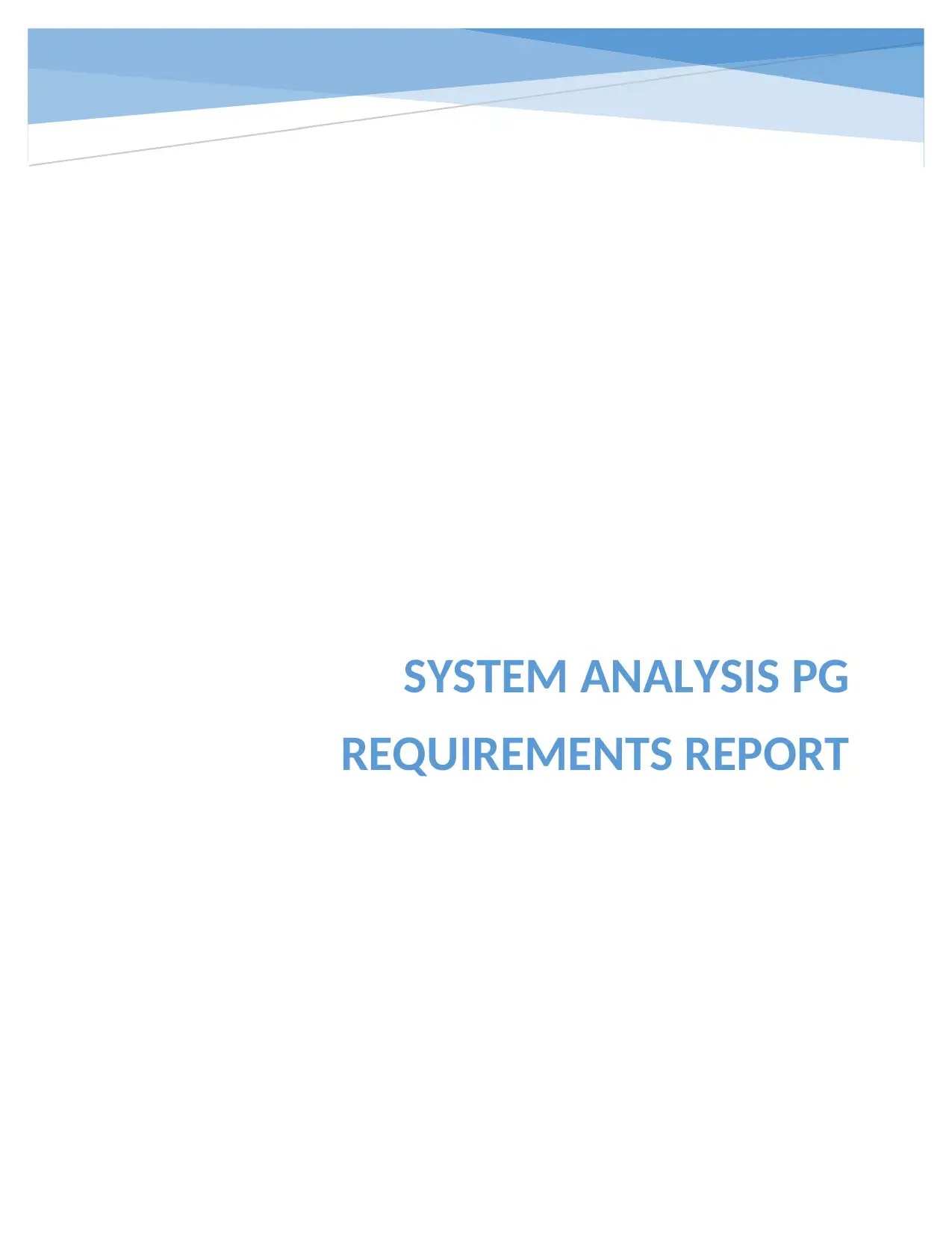
SYSTEM ANALYSIS PG
REQUIREMENTS REPORT
REQUIREMENTS REPORT
Paraphrase This Document
Need a fresh take? Get an instant paraphrase of this document with our AI Paraphraser
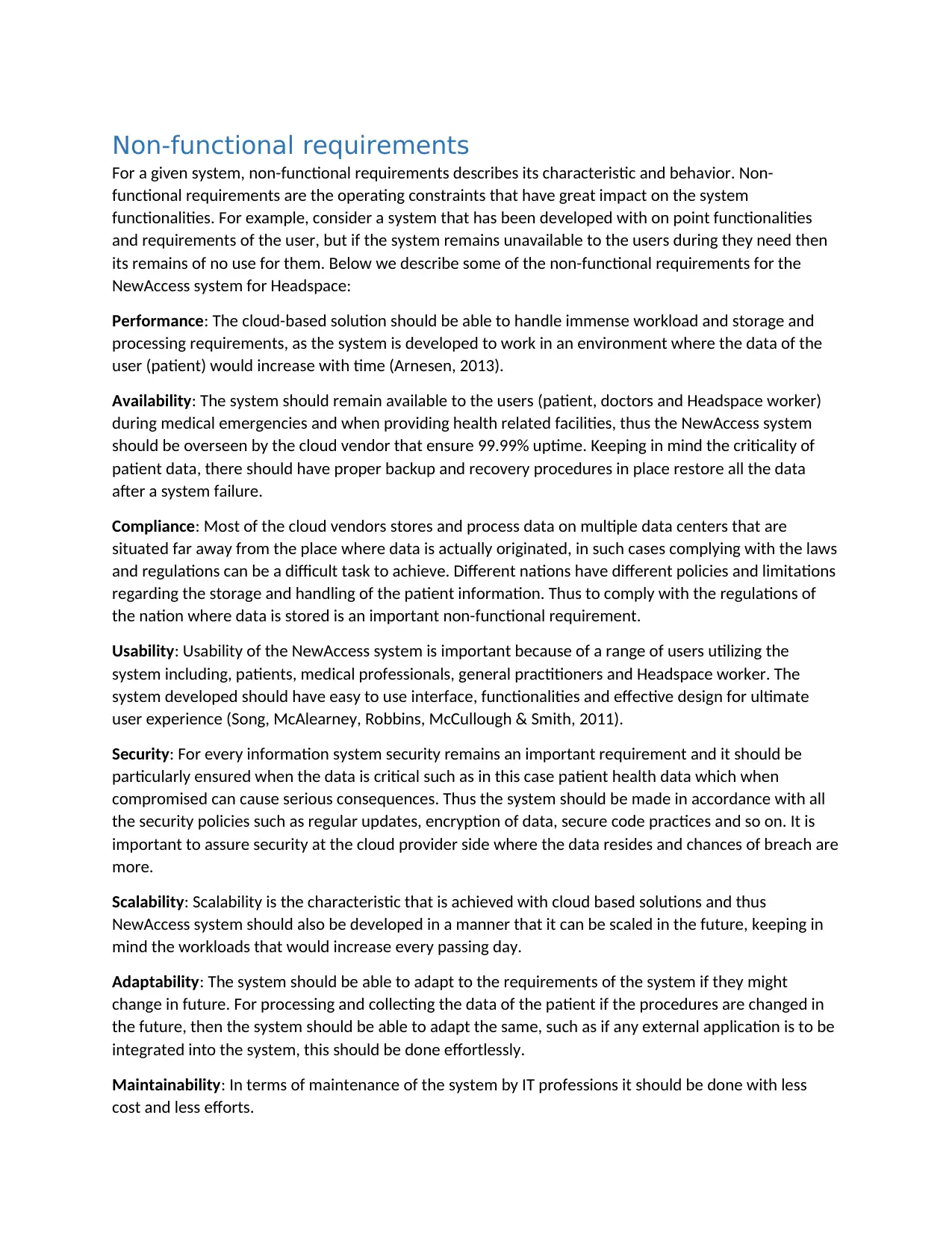
Non-functional requirements
For a given system, non-functional requirements describes its characteristic and behavior. Non-
functional requirements are the operating constraints that have great impact on the system
functionalities. For example, consider a system that has been developed with on point functionalities
and requirements of the user, but if the system remains unavailable to the users during they need then
its remains of no use for them. Below we describe some of the non-functional requirements for the
NewAccess system for Headspace:
Performance: The cloud-based solution should be able to handle immense workload and storage and
processing requirements, as the system is developed to work in an environment where the data of the
user (patient) would increase with time (Arnesen, 2013).
Availability: The system should remain available to the users (patient, doctors and Headspace worker)
during medical emergencies and when providing health related facilities, thus the NewAccess system
should be overseen by the cloud vendor that ensure 99.99% uptime. Keeping in mind the criticality of
patient data, there should have proper backup and recovery procedures in place restore all the data
after a system failure.
Compliance: Most of the cloud vendors stores and process data on multiple data centers that are
situated far away from the place where data is actually originated, in such cases complying with the laws
and regulations can be a difficult task to achieve. Different nations have different policies and limitations
regarding the storage and handling of the patient information. Thus to comply with the regulations of
the nation where data is stored is an important non-functional requirement.
Usability: Usability of the NewAccess system is important because of a range of users utilizing the
system including, patients, medical professionals, general practitioners and Headspace worker. The
system developed should have easy to use interface, functionalities and effective design for ultimate
user experience (Song, McAlearney, Robbins, McCullough & Smith, 2011).
Security: For every information system security remains an important requirement and it should be
particularly ensured when the data is critical such as in this case patient health data which when
compromised can cause serious consequences. Thus the system should be made in accordance with all
the security policies such as regular updates, encryption of data, secure code practices and so on. It is
important to assure security at the cloud provider side where the data resides and chances of breach are
more.
Scalability: Scalability is the characteristic that is achieved with cloud based solutions and thus
NewAccess system should also be developed in a manner that it can be scaled in the future, keeping in
mind the workloads that would increase every passing day.
Adaptability: The system should be able to adapt to the requirements of the system if they might
change in future. For processing and collecting the data of the patient if the procedures are changed in
the future, then the system should be able to adapt the same, such as if any external application is to be
integrated into the system, this should be done effortlessly.
Maintainability: In terms of maintenance of the system by IT professions it should be done with less
cost and less efforts.
For a given system, non-functional requirements describes its characteristic and behavior. Non-
functional requirements are the operating constraints that have great impact on the system
functionalities. For example, consider a system that has been developed with on point functionalities
and requirements of the user, but if the system remains unavailable to the users during they need then
its remains of no use for them. Below we describe some of the non-functional requirements for the
NewAccess system for Headspace:
Performance: The cloud-based solution should be able to handle immense workload and storage and
processing requirements, as the system is developed to work in an environment where the data of the
user (patient) would increase with time (Arnesen, 2013).
Availability: The system should remain available to the users (patient, doctors and Headspace worker)
during medical emergencies and when providing health related facilities, thus the NewAccess system
should be overseen by the cloud vendor that ensure 99.99% uptime. Keeping in mind the criticality of
patient data, there should have proper backup and recovery procedures in place restore all the data
after a system failure.
Compliance: Most of the cloud vendors stores and process data on multiple data centers that are
situated far away from the place where data is actually originated, in such cases complying with the laws
and regulations can be a difficult task to achieve. Different nations have different policies and limitations
regarding the storage and handling of the patient information. Thus to comply with the regulations of
the nation where data is stored is an important non-functional requirement.
Usability: Usability of the NewAccess system is important because of a range of users utilizing the
system including, patients, medical professionals, general practitioners and Headspace worker. The
system developed should have easy to use interface, functionalities and effective design for ultimate
user experience (Song, McAlearney, Robbins, McCullough & Smith, 2011).
Security: For every information system security remains an important requirement and it should be
particularly ensured when the data is critical such as in this case patient health data which when
compromised can cause serious consequences. Thus the system should be made in accordance with all
the security policies such as regular updates, encryption of data, secure code practices and so on. It is
important to assure security at the cloud provider side where the data resides and chances of breach are
more.
Scalability: Scalability is the characteristic that is achieved with cloud based solutions and thus
NewAccess system should also be developed in a manner that it can be scaled in the future, keeping in
mind the workloads that would increase every passing day.
Adaptability: The system should be able to adapt to the requirements of the system if they might
change in future. For processing and collecting the data of the patient if the procedures are changed in
the future, then the system should be able to adapt the same, such as if any external application is to be
integrated into the system, this should be done effortlessly.
Maintainability: In terms of maintenance of the system by IT professions it should be done with less
cost and less efforts.
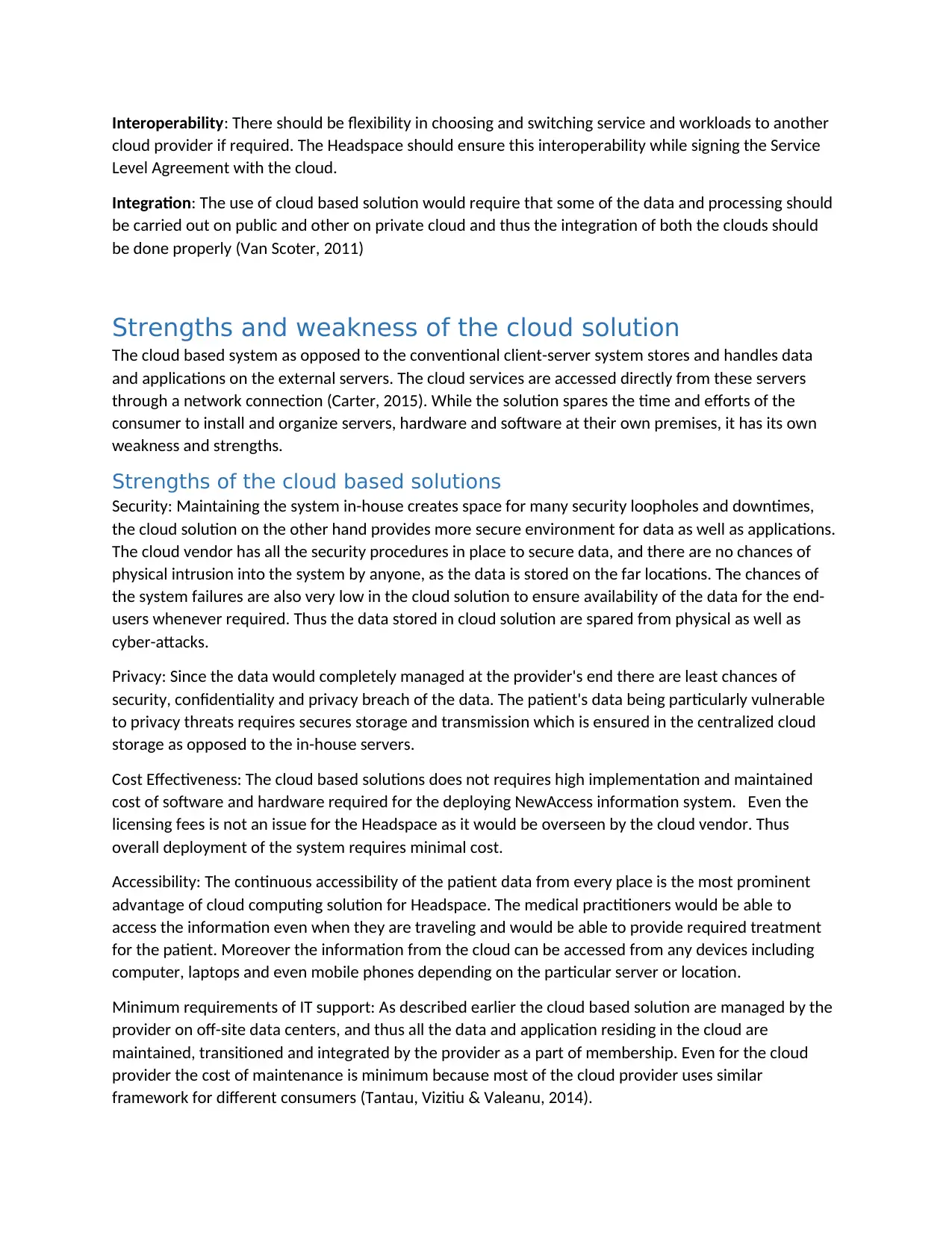
Interoperability: There should be flexibility in choosing and switching service and workloads to another
cloud provider if required. The Headspace should ensure this interoperability while signing the Service
Level Agreement with the cloud.
Integration: The use of cloud based solution would require that some of the data and processing should
be carried out on public and other on private cloud and thus the integration of both the clouds should
be done properly (Van Scoter, 2011)
Strengths and weakness of the cloud solution
The cloud based system as opposed to the conventional client-server system stores and handles data
and applications on the external servers. The cloud services are accessed directly from these servers
through a network connection (Carter, 2015). While the solution spares the time and efforts of the
consumer to install and organize servers, hardware and software at their own premises, it has its own
weakness and strengths.
Strengths of the cloud based solutions
Security: Maintaining the system in-house creates space for many security loopholes and downtimes,
the cloud solution on the other hand provides more secure environment for data as well as applications.
The cloud vendor has all the security procedures in place to secure data, and there are no chances of
physical intrusion into the system by anyone, as the data is stored on the far locations. The chances of
the system failures are also very low in the cloud solution to ensure availability of the data for the end-
users whenever required. Thus the data stored in cloud solution are spared from physical as well as
cyber-attacks.
Privacy: Since the data would completely managed at the provider's end there are least chances of
security, confidentiality and privacy breach of the data. The patient's data being particularly vulnerable
to privacy threats requires secures storage and transmission which is ensured in the centralized cloud
storage as opposed to the in-house servers.
Cost Effectiveness: The cloud based solutions does not requires high implementation and maintained
cost of software and hardware required for the deploying NewAccess information system. Even the
licensing fees is not an issue for the Headspace as it would be overseen by the cloud vendor. Thus
overall deployment of the system requires minimal cost.
Accessibility: The continuous accessibility of the patient data from every place is the most prominent
advantage of cloud computing solution for Headspace. The medical practitioners would be able to
access the information even when they are traveling and would be able to provide required treatment
for the patient. Moreover the information from the cloud can be accessed from any devices including
computer, laptops and even mobile phones depending on the particular server or location.
Minimum requirements of IT support: As described earlier the cloud based solution are managed by the
provider on off-site data centers, and thus all the data and application residing in the cloud are
maintained, transitioned and integrated by the provider as a part of membership. Even for the cloud
provider the cost of maintenance is minimum because most of the cloud provider uses similar
framework for different consumers (Tantau, Vizitiu & Valeanu, 2014).
cloud provider if required. The Headspace should ensure this interoperability while signing the Service
Level Agreement with the cloud.
Integration: The use of cloud based solution would require that some of the data and processing should
be carried out on public and other on private cloud and thus the integration of both the clouds should
be done properly (Van Scoter, 2011)
Strengths and weakness of the cloud solution
The cloud based system as opposed to the conventional client-server system stores and handles data
and applications on the external servers. The cloud services are accessed directly from these servers
through a network connection (Carter, 2015). While the solution spares the time and efforts of the
consumer to install and organize servers, hardware and software at their own premises, it has its own
weakness and strengths.
Strengths of the cloud based solutions
Security: Maintaining the system in-house creates space for many security loopholes and downtimes,
the cloud solution on the other hand provides more secure environment for data as well as applications.
The cloud vendor has all the security procedures in place to secure data, and there are no chances of
physical intrusion into the system by anyone, as the data is stored on the far locations. The chances of
the system failures are also very low in the cloud solution to ensure availability of the data for the end-
users whenever required. Thus the data stored in cloud solution are spared from physical as well as
cyber-attacks.
Privacy: Since the data would completely managed at the provider's end there are least chances of
security, confidentiality and privacy breach of the data. The patient's data being particularly vulnerable
to privacy threats requires secures storage and transmission which is ensured in the centralized cloud
storage as opposed to the in-house servers.
Cost Effectiveness: The cloud based solutions does not requires high implementation and maintained
cost of software and hardware required for the deploying NewAccess information system. Even the
licensing fees is not an issue for the Headspace as it would be overseen by the cloud vendor. Thus
overall deployment of the system requires minimal cost.
Accessibility: The continuous accessibility of the patient data from every place is the most prominent
advantage of cloud computing solution for Headspace. The medical practitioners would be able to
access the information even when they are traveling and would be able to provide required treatment
for the patient. Moreover the information from the cloud can be accessed from any devices including
computer, laptops and even mobile phones depending on the particular server or location.
Minimum requirements of IT support: As described earlier the cloud based solution are managed by the
provider on off-site data centers, and thus all the data and application residing in the cloud are
maintained, transitioned and integrated by the provider as a part of membership. Even for the cloud
provider the cost of maintenance is minimum because most of the cloud provider uses similar
framework for different consumers (Tantau, Vizitiu & Valeanu, 2014).
⊘ This is a preview!⊘
Do you want full access?
Subscribe today to unlock all pages.

Trusted by 1+ million students worldwide
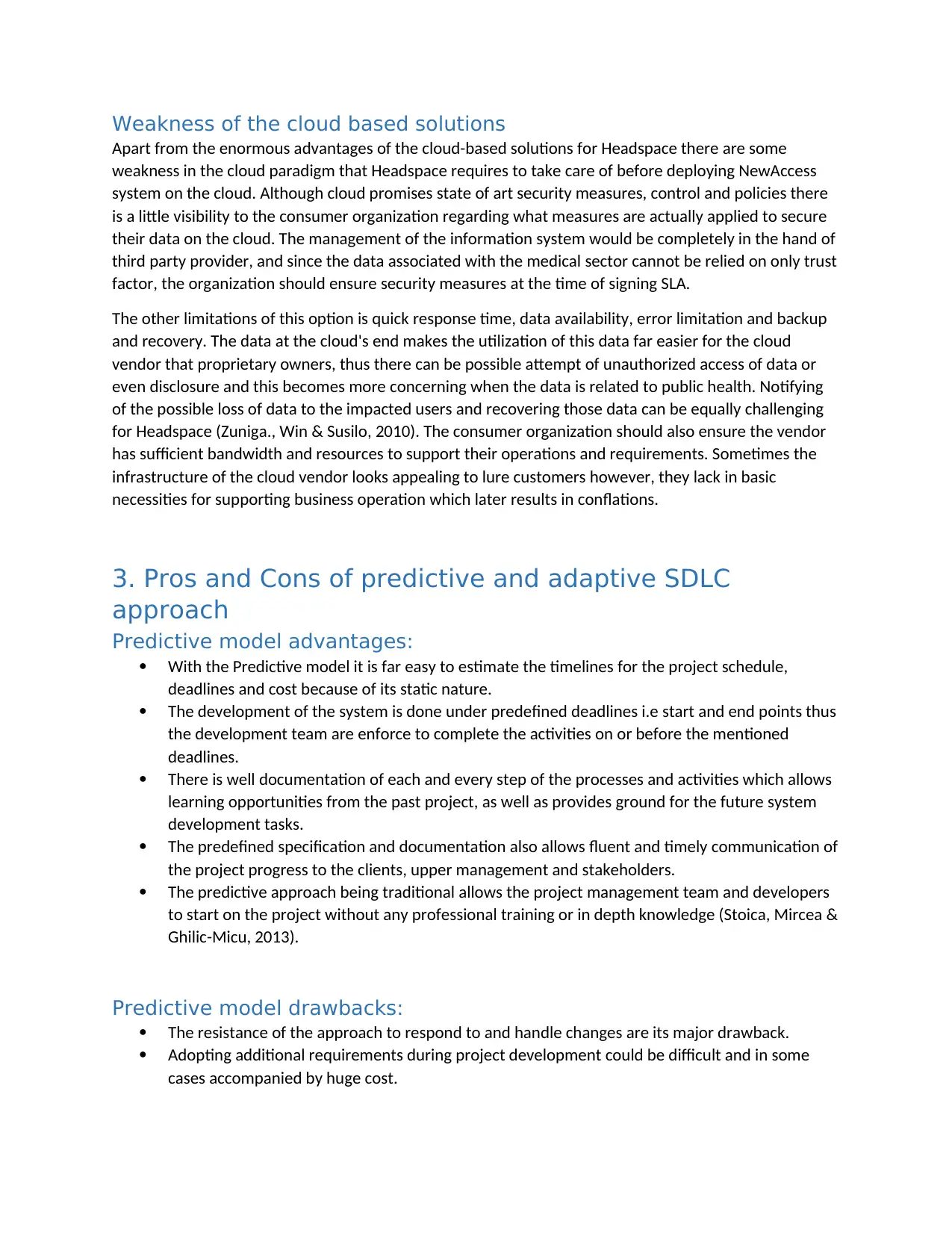
Weakness of the cloud based solutions
Apart from the enormous advantages of the cloud-based solutions for Headspace there are some
weakness in the cloud paradigm that Headspace requires to take care of before deploying NewAccess
system on the cloud. Although cloud promises state of art security measures, control and policies there
is a little visibility to the consumer organization regarding what measures are actually applied to secure
their data on the cloud. The management of the information system would be completely in the hand of
third party provider, and since the data associated with the medical sector cannot be relied on only trust
factor, the organization should ensure security measures at the time of signing SLA.
The other limitations of this option is quick response time, data availability, error limitation and backup
and recovery. The data at the cloud's end makes the utilization of this data far easier for the cloud
vendor that proprietary owners, thus there can be possible attempt of unauthorized access of data or
even disclosure and this becomes more concerning when the data is related to public health. Notifying
of the possible loss of data to the impacted users and recovering those data can be equally challenging
for Headspace (Zuniga., Win & Susilo, 2010). The consumer organization should also ensure the vendor
has sufficient bandwidth and resources to support their operations and requirements. Sometimes the
infrastructure of the cloud vendor looks appealing to lure customers however, they lack in basic
necessities for supporting business operation which later results in conflations.
3. Pros and Cons of predictive and adaptive SDLC
approach
Predictive model advantages:
With the Predictive model it is far easy to estimate the timelines for the project schedule,
deadlines and cost because of its static nature.
The development of the system is done under predefined deadlines i.e start and end points thus
the development team are enforce to complete the activities on or before the mentioned
deadlines.
There is well documentation of each and every step of the processes and activities which allows
learning opportunities from the past project, as well as provides ground for the future system
development tasks.
The predefined specification and documentation also allows fluent and timely communication of
the project progress to the clients, upper management and stakeholders.
The predictive approach being traditional allows the project management team and developers
to start on the project without any professional training or in depth knowledge (Stoica, Mircea &
Ghilic-Micu, 2013).
Predictive model drawbacks:
The resistance of the approach to respond to and handle changes are its major drawback.
Adopting additional requirements during project development could be difficult and in some
cases accompanied by huge cost.
Apart from the enormous advantages of the cloud-based solutions for Headspace there are some
weakness in the cloud paradigm that Headspace requires to take care of before deploying NewAccess
system on the cloud. Although cloud promises state of art security measures, control and policies there
is a little visibility to the consumer organization regarding what measures are actually applied to secure
their data on the cloud. The management of the information system would be completely in the hand of
third party provider, and since the data associated with the medical sector cannot be relied on only trust
factor, the organization should ensure security measures at the time of signing SLA.
The other limitations of this option is quick response time, data availability, error limitation and backup
and recovery. The data at the cloud's end makes the utilization of this data far easier for the cloud
vendor that proprietary owners, thus there can be possible attempt of unauthorized access of data or
even disclosure and this becomes more concerning when the data is related to public health. Notifying
of the possible loss of data to the impacted users and recovering those data can be equally challenging
for Headspace (Zuniga., Win & Susilo, 2010). The consumer organization should also ensure the vendor
has sufficient bandwidth and resources to support their operations and requirements. Sometimes the
infrastructure of the cloud vendor looks appealing to lure customers however, they lack in basic
necessities for supporting business operation which later results in conflations.
3. Pros and Cons of predictive and adaptive SDLC
approach
Predictive model advantages:
With the Predictive model it is far easy to estimate the timelines for the project schedule,
deadlines and cost because of its static nature.
The development of the system is done under predefined deadlines i.e start and end points thus
the development team are enforce to complete the activities on or before the mentioned
deadlines.
There is well documentation of each and every step of the processes and activities which allows
learning opportunities from the past project, as well as provides ground for the future system
development tasks.
The predefined specification and documentation also allows fluent and timely communication of
the project progress to the clients, upper management and stakeholders.
The predictive approach being traditional allows the project management team and developers
to start on the project without any professional training or in depth knowledge (Stoica, Mircea &
Ghilic-Micu, 2013).
Predictive model drawbacks:
The resistance of the approach to respond to and handle changes are its major drawback.
Adopting additional requirements during project development could be difficult and in some
cases accompanied by huge cost.
Paraphrase This Document
Need a fresh take? Get an instant paraphrase of this document with our AI Paraphraser
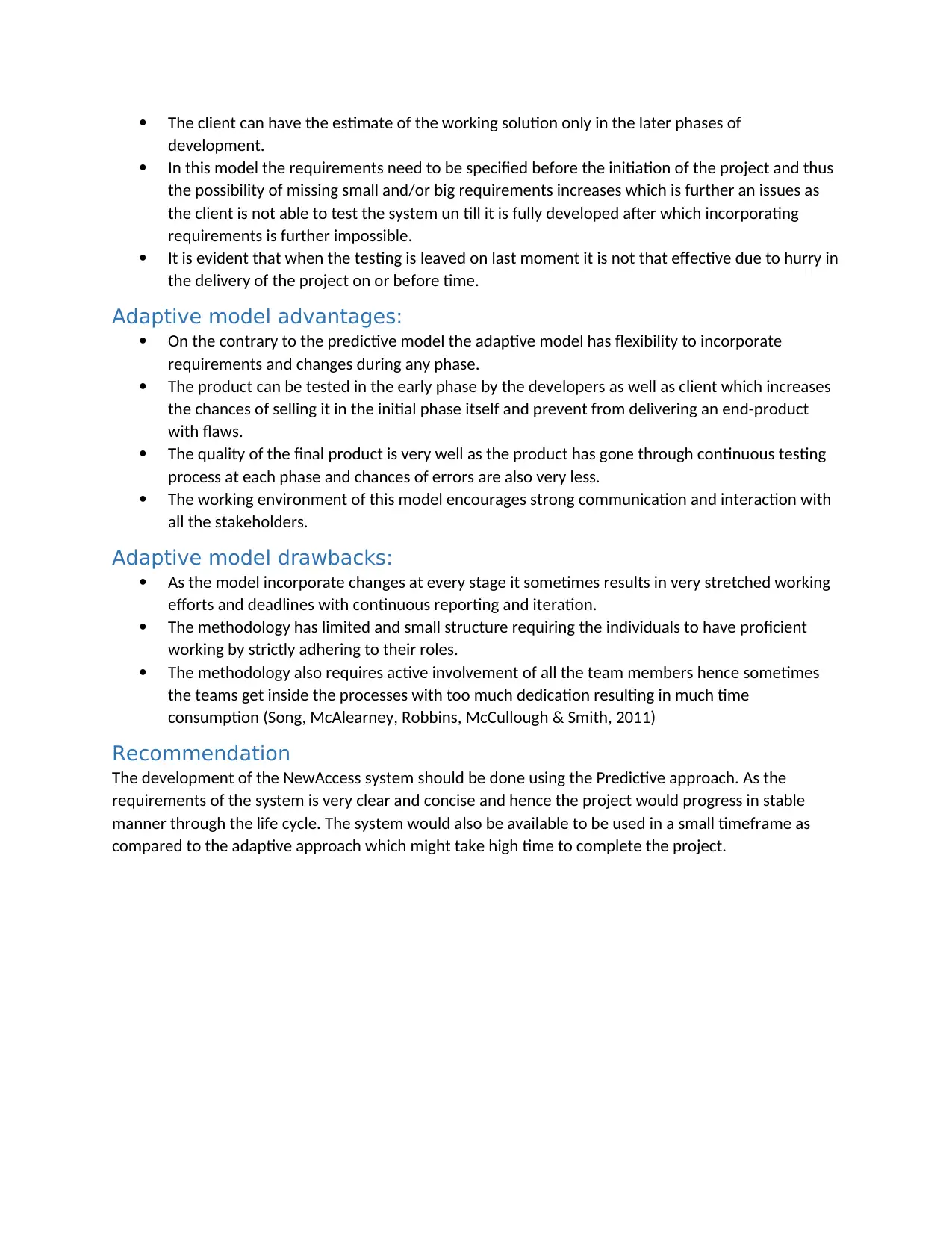
The client can have the estimate of the working solution only in the later phases of
development.
In this model the requirements need to be specified before the initiation of the project and thus
the possibility of missing small and/or big requirements increases which is further an issues as
the client is not able to test the system un till it is fully developed after which incorporating
requirements is further impossible.
It is evident that when the testing is leaved on last moment it is not that effective due to hurry in
the delivery of the project on or before time.
Adaptive model advantages:
On the contrary to the predictive model the adaptive model has flexibility to incorporate
requirements and changes during any phase.
The product can be tested in the early phase by the developers as well as client which increases
the chances of selling it in the initial phase itself and prevent from delivering an end-product
with flaws.
The quality of the final product is very well as the product has gone through continuous testing
process at each phase and chances of errors are also very less.
The working environment of this model encourages strong communication and interaction with
all the stakeholders.
Adaptive model drawbacks:
As the model incorporate changes at every stage it sometimes results in very stretched working
efforts and deadlines with continuous reporting and iteration.
The methodology has limited and small structure requiring the individuals to have proficient
working by strictly adhering to their roles.
The methodology also requires active involvement of all the team members hence sometimes
the teams get inside the processes with too much dedication resulting in much time
consumption (Song, McAlearney, Robbins, McCullough & Smith, 2011)
Recommendation
The development of the NewAccess system should be done using the Predictive approach. As the
requirements of the system is very clear and concise and hence the project would progress in stable
manner through the life cycle. The system would also be available to be used in a small timeframe as
compared to the adaptive approach which might take high time to complete the project.
development.
In this model the requirements need to be specified before the initiation of the project and thus
the possibility of missing small and/or big requirements increases which is further an issues as
the client is not able to test the system un till it is fully developed after which incorporating
requirements is further impossible.
It is evident that when the testing is leaved on last moment it is not that effective due to hurry in
the delivery of the project on or before time.
Adaptive model advantages:
On the contrary to the predictive model the adaptive model has flexibility to incorporate
requirements and changes during any phase.
The product can be tested in the early phase by the developers as well as client which increases
the chances of selling it in the initial phase itself and prevent from delivering an end-product
with flaws.
The quality of the final product is very well as the product has gone through continuous testing
process at each phase and chances of errors are also very less.
The working environment of this model encourages strong communication and interaction with
all the stakeholders.
Adaptive model drawbacks:
As the model incorporate changes at every stage it sometimes results in very stretched working
efforts and deadlines with continuous reporting and iteration.
The methodology has limited and small structure requiring the individuals to have proficient
working by strictly adhering to their roles.
The methodology also requires active involvement of all the team members hence sometimes
the teams get inside the processes with too much dedication resulting in much time
consumption (Song, McAlearney, Robbins, McCullough & Smith, 2011)
Recommendation
The development of the NewAccess system should be done using the Predictive approach. As the
requirements of the system is very clear and concise and hence the project would progress in stable
manner through the life cycle. The system would also be available to be used in a small timeframe as
compared to the adaptive approach which might take high time to complete the project.
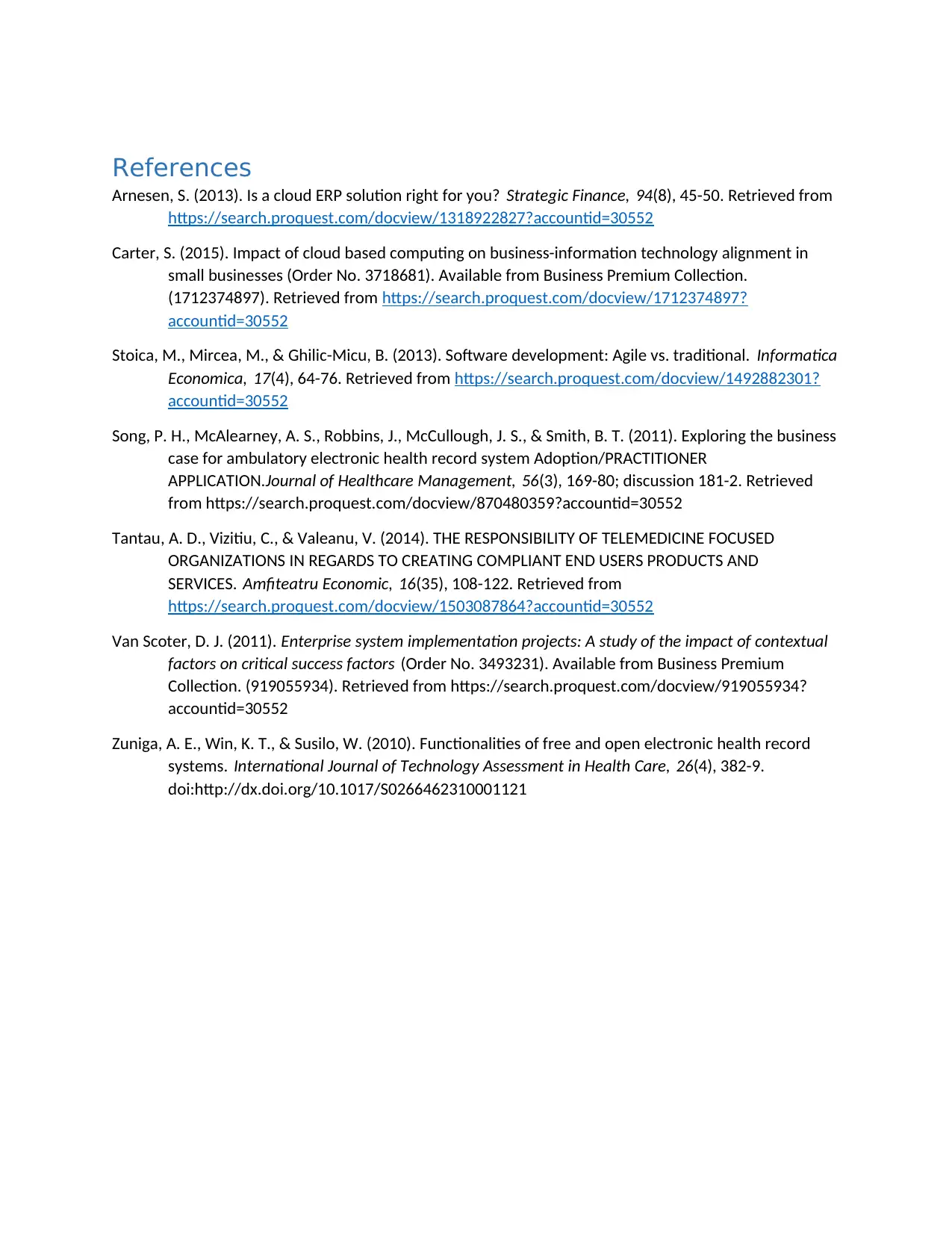
References
Arnesen, S. (2013). Is a cloud ERP solution right for you? Strategic Finance, 94(8), 45-50. Retrieved from
https://search.proquest.com/docview/1318922827?accountid=30552
Carter, S. (2015). Impact of cloud based computing on business-information technology alignment in
small businesses (Order No. 3718681). Available from Business Premium Collection.
(1712374897). Retrieved from https://search.proquest.com/docview/1712374897?
accountid=30552
Stoica, M., Mircea, M., & Ghilic-Micu, B. (2013). Software development: Agile vs. traditional. Informatica
Economica, 17(4), 64-76. Retrieved from https://search.proquest.com/docview/1492882301?
accountid=30552
Song, P. H., McAlearney, A. S., Robbins, J., McCullough, J. S., & Smith, B. T. (2011). Exploring the business
case for ambulatory electronic health record system Adoption/PRACTITIONER
APPLICATION.Journal of Healthcare Management, 56(3), 169-80; discussion 181-2. Retrieved
from https://search.proquest.com/docview/870480359?accountid=30552
Tantau, A. D., Vizitiu, C., & Valeanu, V. (2014). THE RESPONSIBILITY OF TELEMEDICINE FOCUSED
ORGANIZATIONS IN REGARDS TO CREATING COMPLIANT END USERS PRODUCTS AND
SERVICES. Amfiteatru Economic, 16(35), 108-122. Retrieved from
https://search.proquest.com/docview/1503087864?accountid=30552
Van Scoter, D. J. (2011). Enterprise system implementation projects: A study of the impact of contextual
factors on critical success factors (Order No. 3493231). Available from Business Premium
Collection. (919055934). Retrieved from https://search.proquest.com/docview/919055934?
accountid=30552
Zuniga, A. E., Win, K. T., & Susilo, W. (2010). Functionalities of free and open electronic health record
systems. International Journal of Technology Assessment in Health Care, 26(4), 382-9.
doi:http://dx.doi.org/10.1017/S0266462310001121
Arnesen, S. (2013). Is a cloud ERP solution right for you? Strategic Finance, 94(8), 45-50. Retrieved from
https://search.proquest.com/docview/1318922827?accountid=30552
Carter, S. (2015). Impact of cloud based computing on business-information technology alignment in
small businesses (Order No. 3718681). Available from Business Premium Collection.
(1712374897). Retrieved from https://search.proquest.com/docview/1712374897?
accountid=30552
Stoica, M., Mircea, M., & Ghilic-Micu, B. (2013). Software development: Agile vs. traditional. Informatica
Economica, 17(4), 64-76. Retrieved from https://search.proquest.com/docview/1492882301?
accountid=30552
Song, P. H., McAlearney, A. S., Robbins, J., McCullough, J. S., & Smith, B. T. (2011). Exploring the business
case for ambulatory electronic health record system Adoption/PRACTITIONER
APPLICATION.Journal of Healthcare Management, 56(3), 169-80; discussion 181-2. Retrieved
from https://search.proquest.com/docview/870480359?accountid=30552
Tantau, A. D., Vizitiu, C., & Valeanu, V. (2014). THE RESPONSIBILITY OF TELEMEDICINE FOCUSED
ORGANIZATIONS IN REGARDS TO CREATING COMPLIANT END USERS PRODUCTS AND
SERVICES. Amfiteatru Economic, 16(35), 108-122. Retrieved from
https://search.proquest.com/docview/1503087864?accountid=30552
Van Scoter, D. J. (2011). Enterprise system implementation projects: A study of the impact of contextual
factors on critical success factors (Order No. 3493231). Available from Business Premium
Collection. (919055934). Retrieved from https://search.proquest.com/docview/919055934?
accountid=30552
Zuniga, A. E., Win, K. T., & Susilo, W. (2010). Functionalities of free and open electronic health record
systems. International Journal of Technology Assessment in Health Care, 26(4), 382-9.
doi:http://dx.doi.org/10.1017/S0266462310001121
⊘ This is a preview!⊘
Do you want full access?
Subscribe today to unlock all pages.

Trusted by 1+ million students worldwide
1 out of 6
Related Documents
Your All-in-One AI-Powered Toolkit for Academic Success.
+13062052269
info@desklib.com
Available 24*7 on WhatsApp / Email
![[object Object]](/_next/static/media/star-bottom.7253800d.svg)
Unlock your academic potential
Copyright © 2020–2025 A2Z Services. All Rights Reserved. Developed and managed by ZUCOL.





